Table of contents
- Introduction: Discover the Power of Garden Obelisks
- Supporting Climbing Plants Effectively
- Supporting Climbing Plants with an Obelisk: A Quick Overview
- Maximizing Garden Space:
- Functional and Decorative Purposes
- Why Obelisks are Beneficial
- Benefits of Using Garden Obelisks
- Placement in Various Garden Types
- Placement of Garden Obelisks in Various Garden Types
- Best Plants for Obelisks
- Best Plants for Garden Obelisks
- Conclusion: Embrace the Transformative Power of Garden Obelisks
Introduction: Discover the Power of Garden Obelisks
As a professional gardener, I’ve learned how to use garden obelisks to transform countless gardens into beautiful spaces. My journey with garden obelisks began in a sprawling English garden. I was tasked with rejuvenating a neglected flower bed. Amid the overgrowth, an old, weathered obelisk stood tall, covered in a tangle of ivy. Despite the surrounding chaos, it maintained a sense of order and grace. This moment sparked my fascination with these elegant structures.
Versatility Across Garden Styles
Over the years, I’ve experimented with various garden styles. These range from the structured symmetry of formal gardens to the charm of cottage gardens. In every setting, obelisks have proven indispensable. They offer a unique blend of functionality and aesthetics. Obelisks provide essential support for climbing plants. They also serve as striking focal points.
Why Obelisks Matter
Obelisks are perfect for maximizing space in compact urban gardens. They also add elegance to traditional landscapes. They are more than just decorative elements. Obelisks are tools that can elevate your garden’s design and health.
What You’ll Learn
In this article, I’ll share insights on using garden obelisks effectively. We’ll explore their functional and decorative purposes. We will also discuss the best plants to pair with them. Lastly, we’ll see how they can be adapted to different garden styles. Whether you’re a seasoned gardener or just starting out, you’ll find practical tips here. This article will help you make the most of these versatile structures.
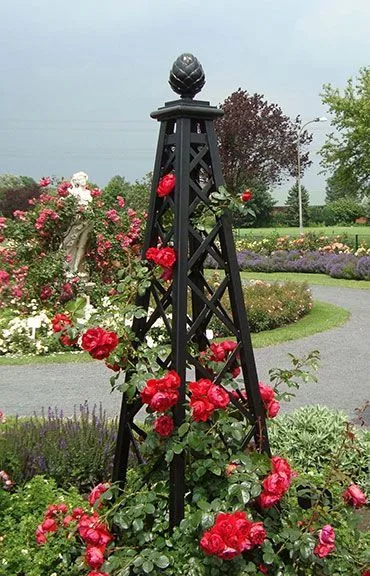
Supporting Climbing Plants Effectively
Understanding how to use a garden obelisk is crucial for maximizing its potential as a plant support structure. By offering vertical support, obelisks allow plants like clematis, roses, and vegetable vines such as peas and beans to grow upward, maximizing space and enhancing plant health. This vertical growth is beneficial because:
- Improved Air Circulation: As plants climb a garden obelisk, the increased airflow around the foliage reduces the risk of fungal diseases, which thrive in stagnant, moist environments. This is particularly important for dense plants like beans and clematis, which can easily develop mildew if not properly ventilated.
- Better Sunlight Exposure: Vertical growth ensures that more parts of the plant receive sunlight, which is essential for photosynthesis. This exposure leads to stronger, healthier plants with more blooms or fruit.
- Efficient Use of Space: Especially in urban or small-space gardens, obelisks allow for vertical gardening. By growing plants up instead of out, gardeners can achieve higher yields in limited spaces. This is particularly beneficial for vegetables like peas and cucumbers, which can be grown on obelisks to free up ground space for other crops.
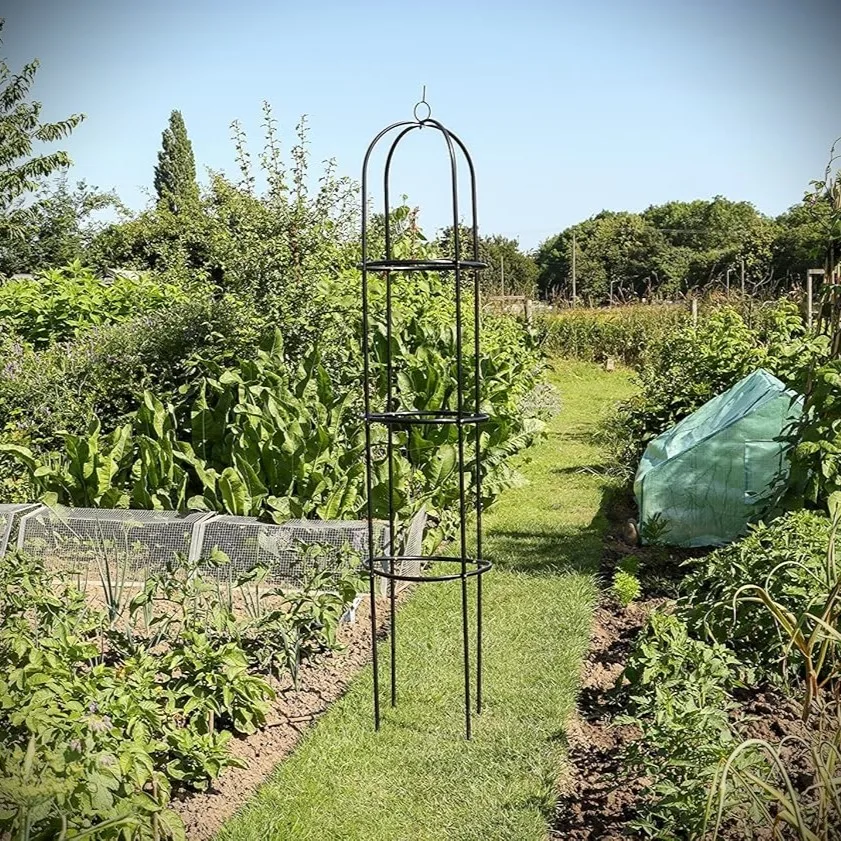
Steel Garden Obelisk
Consider using a sturdy obelisk like the 1.9m DIVCHI Steel Garden Obelisk, which provides optimal support for climbing plants such as clematis and roses. Its durable design ensures long-lasting use in all weather conditions.
Supporting Climbing Plants with an Obelisk: A Quick Overview
Obelisks are an excellent choice for supporting a variety of climbing plants in your garden. Their vertical structure encourages healthy growth and adds a striking visual element to your outdoor space. Whether you’re growing flowering vines or vegetables, obelisks offer sturdy and attractive support.
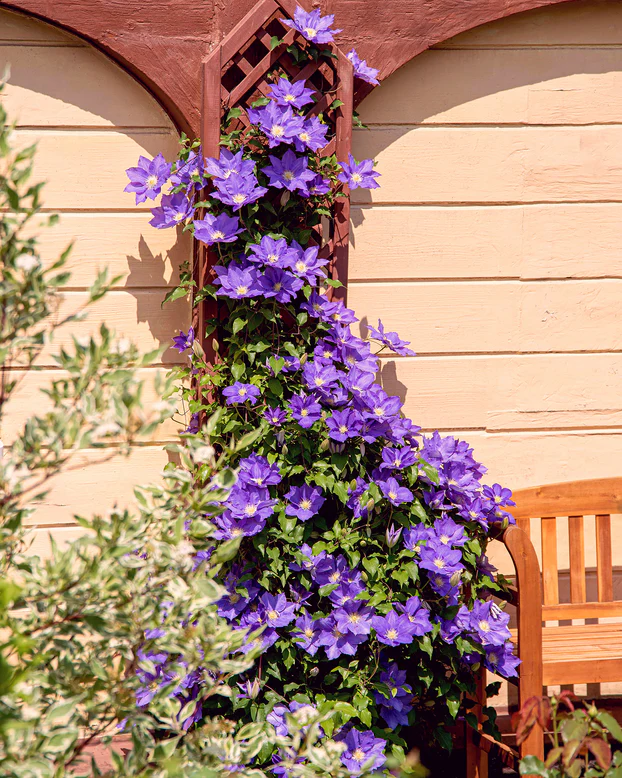
Clematis Support with an Obelisk
Clematis, a popular climbing plant, thrives when paired with an obelisk. To properly support clematis with an obelisk, plant the clematis just outside the obelisk base, giving the roots enough space to spread while ensuring the vine has easy access to climb the structure. As the plant grows, gently guide the clematis vine to wrap around the obelisk for optimal support.
To guide your clematis as it grows, use PGarden-EZ Green Soft Twist Ties. These gentle yet sturdy ties ensure your plants stay securely attached to the obelisk without damaging the stems.
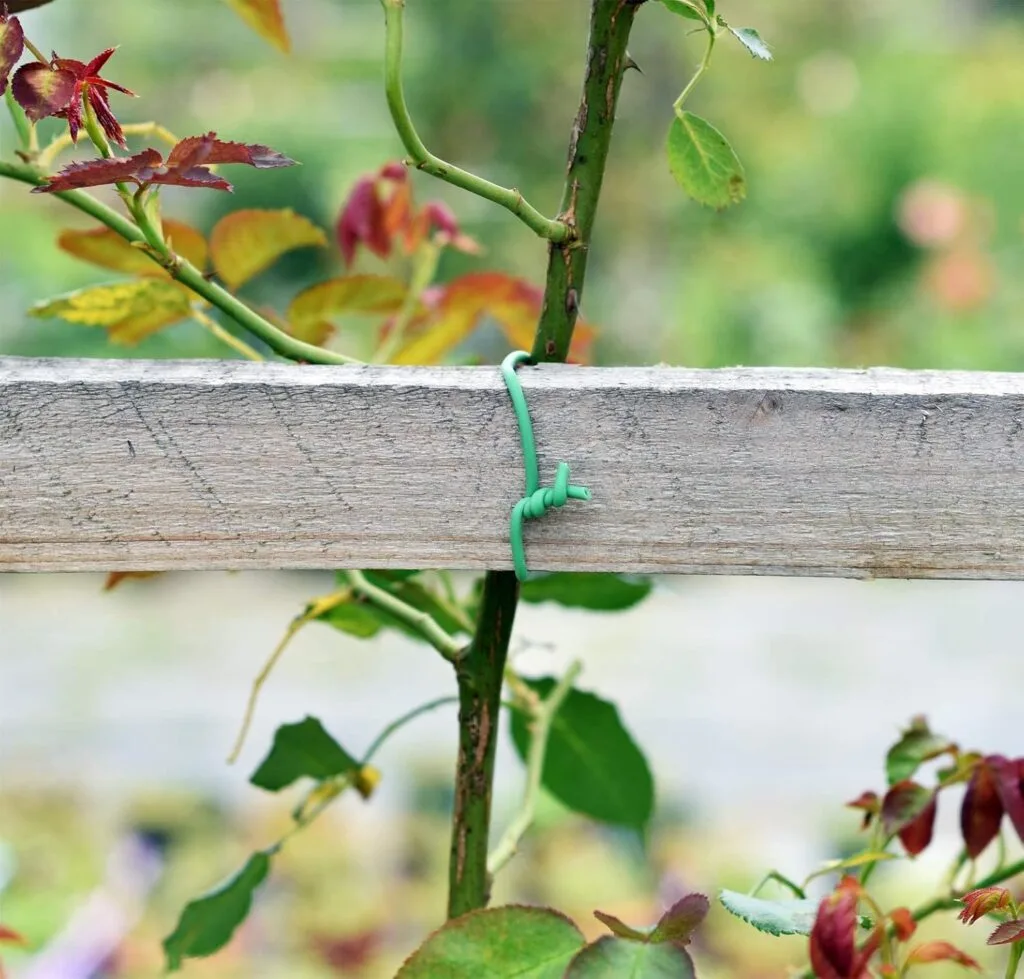
Other Popular Climbing Plants for Obelisks
- Roses: Climbing roses benefit from the obelisk’s height and structure, allowing the plant’s long canes to grow vertically.
- Sweet Peas: With the support of an obelisk, sweet peas can grow tall and produce abundant blooms.
- Honeysuckle: Honeysuckle vines will naturally twine around the obelisk, offering a vertical display of fragrant flowers.
Need Specific Plant Support Advice?
If you’re looking for more detailed guidance on how to support specific climbing plants, including whether to plant clematis inside or outside an obelisk, check out our plant-specific articles:
- How to Support Clematis with an Obelisk – Best practices for planting and training clematis on an obelisk, including whether to plant inside or outside the structure.
- Using Obelisks for Roses – Tips for helping climbing roses flourish on obelisks.
- Training Sweet Peas with an Obelisk – Step-by-step instructions for growing healthy sweet peas on an obelisk.
By providing the right support, your climbing plants will thrive, creating a stunning vertical element in your garden.
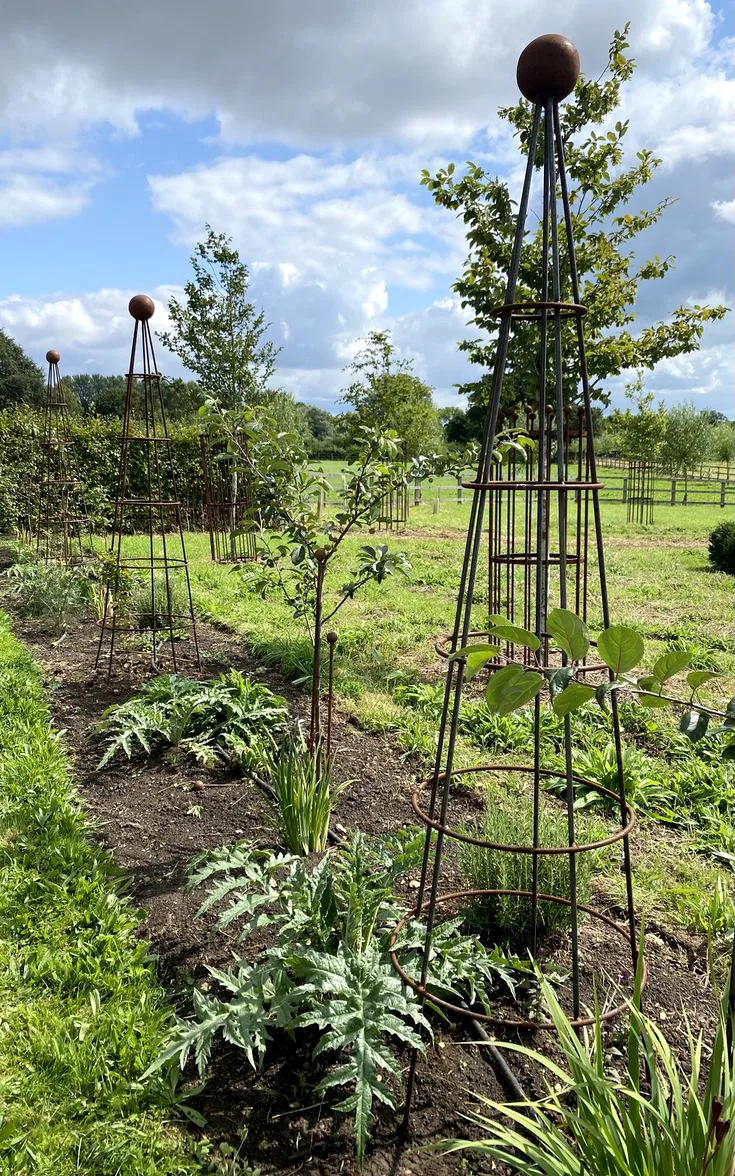
Maximizing Garden Space:
Vertical gardening with obelisks makes the most of limited space. In small gardens or urban settings where horizontal space is at a premium, obelisks offer a practical solution:
- Higher Yields in Compact Spaces: By using the vertical space, obelisks allow gardeners to grow more plants without needing to expand the garden’s footprint. This is particularly advantageous for crops like tomatoes and beans, which thrive when grown vertically.
- Urban Garden Solutions: In densely populated urban areas where garden space is often limited to small plots or containers, obelisks enable gardeners to create lush, productive gardens in confined spaces. This can transform a small patio or balcony into a productive green space.
Keep your climbing plants healthy with Kimura® 8″ Pro Bypass Garden Secateurs. These precision shears make it easy to trim overgrowth and encourage optimal plant health.

Decorative Uses:
Creating Eye-Catching Focal Points:
Beyond their practical applications, obelisks serve as striking focal points in a garden. Their tall, structured design naturally draws the eye, adding height and definition to garden spaces. Key ways obelisks enhance garden aesthetics include:
- Adding Height and Structure: Obelisks can break up the monotony of low-growing plants, adding vertical interest and guiding the viewer’s gaze upward. This can make a garden feel more dynamic and visually engaging.
- Strategic Placement: When placed at the center of a garden bed, along pathways, or flanking an entryway, obelisks create visual anchors that can define and organize a garden’s layout. For instance, a pair of obelisks at the entrance to a garden pathway can create a sense of symmetry and welcome.
Enhancing Seasonal Decor:
Obelisks offer year-round decorative possibilities, enhancing the garden’s appearance across different seasons:
- Winter Decorations: In the colder months, when many plants die back or go dormant, obelisks can be adorned with fairy lights, garlands, or seasonal decorations. This keeps the garden lively and festive, even when plants are not in bloom.
- Spring and Summer Flourishes: During the growing season, obelisks can be surrounded by flowering plants, which not only climb but also cascade down, creating a lush and colorful display. This versatility allows gardeners to adapt their garden’s look with the changing seasons, keeping it vibrant and appealing throughout the year.

For a magical winter display, wrap your obelisks in SMY Lighting Solar Rope fairy lights. These energy-efficient lights add a festive touch to your garden while requiring minimal maintenance.
In summary, garden obelisks are multifunctional structures that provide both practical support for plants and aesthetic enhancements to garden spaces. Whether used for vertical gardening in small spaces or as decorative focal points, obelisks add value to any garden by combining form and function.
To improve the table for the Functional and Decorative Purposes section, we can enhance the information, boost SEO, and increase engagement by adding more detailed descriptions, incorporating additional keywords, and making the table more interactive and visually engaging. Here’s how:
Functional and Decorative Purposes
| Purpose | Specific Function | Best Suited Plants | Maintenance Considerations | SEO Keywords |
| Functional: Plant Support | Supports climbing plants; essential for vertical gardening | Clematis, peas, beans, cucumbers | Regularly check plant weight distribution; anchor securely | Climbing plants, vertical gardening, plant support |
| Functional: Space Maximization | Optimizes limited garden space by encouraging upward growth | Vegetables like beans, cucumbers, tomatoes | Prune regularly to prevent overcrowding; ensure stability | Space-saving gardening, compact gardens, vertical growth |
| Functional: Soil Health | Reduces ground contact, improving soil conditions and plant health | Vining vegetables, trailing flowers | Rotate crops seasonally; monitor for soil depletion | Soil health, garden maintenance, vertical planting |
| Decorative: Focal Points | Creates visual interest and enhances garden design | Climbing roses, ivy, wisteria | Keep the obelisk clean and well-maintained for visual appeal | Garden aesthetics, garden decoration, focal point |
| Decorative: Seasonal Decoration | Enhances garden’s appearance with seasonal displays | Evergreen vines, decorative lights | Change decorations seasonally; use weather-resistant materials | Seasonal gardening, garden decoration, winter garden |
Why Obelisks are Beneficial
Vertical Gardening
Maximizing Space and Plant Health:
One of the primary benefits of using obelisks in your garden is their significant contribution to vertical gardening. By training plants to climb an obelisk, you not only save valuable ground space but also create a healthier environment for your plants. This vertical growth offers several key advantages:
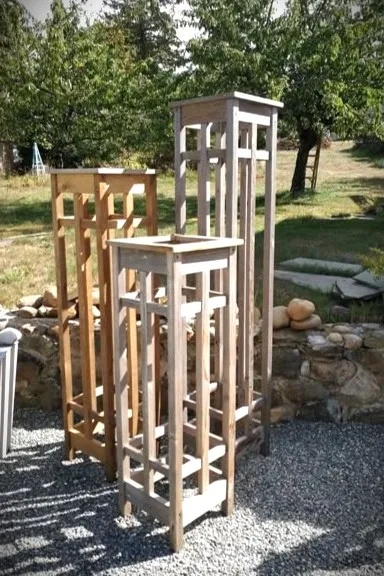
- Improved Airflow: As plants grow vertically around an obelisk, there is better air circulation around the foliage. This increased airflow helps reduce the risk of fungal diseases, which are more likely to develop in crowded, poorly ventilated areas. Proper ventilation is crucial for plants like tomatoes and peas, which are prone to mildew and other fungal issues.
- Enhanced Sunlight Exposure: Vertical gardening ensures that more parts of the plant receive adequate sunlight. This is particularly important for flowering plants and vegetables, as consistent sunlight is essential for photosynthesis, leading to stronger, more productive plants. For instance, growing cucumbers or clematis on an obelisk allows the entire plant to benefit from uniform light distribution, promoting even growth and more abundant blooms or fruit.
- Space Optimization: In small or urban gardens, where horizontal space is limited, vertical gardening with obelisks allows gardeners to maximize their planting area. By growing plants upwards instead of outwards, you can cultivate more varieties in a confined space. This is ideal for urban gardeners who need to make the most of every square inch of their garden.
Seasonal Versatility:
Year-Round Garden Enhancement:
Obelisks are not just for the growing season; they are highly versatile garden features that can enhance your garden’s appearance and functionality throughout the year:
- Spring and Summer: During the warmer months, obelisks serve as vital supports for a variety of plants, from blooming flowers like wisteria and climbing roses to climbing vegetables such as beans and cucumbers. Their ability to support these plants in vertical growth contributes to a lush, vibrant garden filled with color and produce.
- Fall and Winter: As the growing season comes to an end, obelisks continue to add value to your garden. They can be decorated with seasonal elements like lights, evergreen garlands, or even ornamental features such as bird feeders or small lanterns. This not only keeps your garden looking attractive during the colder months but also provides structure and interest when many other plants have died back or gone dormant.
Adaptability Across Seasons:
The versatility of obelisks means they can be adapted to suit the changing seasons, ensuring that your garden remains visually appealing year-round. In winter, an obelisk wrapped in lights or adorned with festive decorations can transform a bare garden into a magical winter wonderland. In spring, the same obelisk can support the first climbing flowers of the season, transitioning smoothly from one season to the next without needing to be moved or replaced.
Benefits of Using Garden Obelisks
| Benefit | Description | Example Plants | Seasonal Adaptation | SEO Keywords |
| Vertical Gardening | Maximizes space by growing plants upward; improves plant health | Clematis, cucumbers, tomatoes | Supports growth in spring/summer; decorates in fall/winter | Vertical gardening, space optimization, plant health |
| Improved Air Circulation | Reduces risk of fungal diseases by enhancing airflow | Beans, peas, roses | Promotes healthier growth during all seasons | Airflow, disease prevention, healthy plants |
| Enhanced Sunlight Exposure | Ensures even sunlight distribution for stronger, more productive plants | Wisteria, climbing roses | Critical in spring/summer for flowering and fruiting | Sunlight exposure, photosynthesis, plant productivity |
| Seasonal Versatility | Adds visual interest year-round; adaptable for all seasons | Evergreen vines, decorative lights | Decorate with lights/garlands in winter; supports blooms in summer | Seasonal gardening, year-round appeal, winter garden |
Placement in Various Garden Types
Formal Gardens

Creating Symmetry and Structure:
In formal gardens, how to use a garden obelisk effectively centers on enhancing symmetry and structure. Obelisks are perfect for creating balanced, visually striking designs that emphasize order and elegance.
Symmetrical Placement:
Place obelisks at regular intervals, such as along pathways or at the ends of flower beds. This placement reinforces the geometric layout typical of formal gardens. Symmetry guides the viewer’s eye and creates a sense of order and sophistication.
Enhancing Focal Points:
Obelisks can also be placed at central points in the garden. For example, place them at the intersection of paths or in the center of a formal lawn. This placement draws attention to specific areas and adds height and grandeur, making the garden appear more majestic.
Complementing Plant Choices:
In formal gardens, obelisks can support climbing plants like roses or topiary ivy. These plants emphasize the structured, manicured appearance. Regular pruning is essential to maintain the formal aesthetic and prevent overgrowth.
Cottage Gardens

Adding Charm and Whimsy:
In a cottage garden, how to use a garden obelisk is more about adding charm and whimsy than strict symmetry. Cottage gardens are known for their informal, free-flowing designs. Obelisks play a key role in enhancing this aesthetic.
Off-Center Placement:
To create a more relaxed, natural look, place obelisks slightly off-center or in seemingly random spots within the garden. This placement adds to the garden’s informal charm, making it feel as though the obelisks are naturally integrated into the landscape.
Surrounding with Free-Flowing Plants:
Surround obelisks with a variety of free-flowing plants and flowers, such as foxgloves, delphiniums, or climbing sweet peas. The combination of vertical obelisks with these softer, trailing plants creates a harmonious blend of structure and nature.
Varied Heights and Styles:
Using obelisks of different heights and styles can enhance the whimsical nature of a cottage garden. Wooden or rustic metal obelisks, in particular, complement the casual, homey feel of these gardens.
Vegetable Gardens:

Maximizing Growing Space and Efficiency:
In vegetable gardens, how to use a garden obelisk is centered on maximizing growing space and improving plant productivity. Obelisks are practical tools that allow gardeners to make the most of limited space by growing plants vertically:
- Strategic Placement for Crop Support: Place obelisks strategically within the garden bed to support climbing vegetables like beans, peas, or cucumbers. This vertical growth frees up horizontal space, allowing more room for other crops or companion plants. It also helps in keeping the garden organized and easier to manage.
- Enhanced Airflow and Sunlight: Positioning obelisks in a way that maximizes sunlight exposure ensures that climbing vegetables receive adequate light, which is essential for photosynthesis and fruit production. The vertical arrangement also improves airflow around the plants, reducing the risk of diseases.
- Rotational Planting: Obelisks can be moved or rotated within the garden to support different crops each season. This flexibility helps in maintaining soil health and allows for efficient use of space throughout the growing year.
For more detailed guidance on growing tomatoes vertically on an obelisk, check out our comprehensive guide on How to Grow Tomatoes in the UK.
Placement of Garden Obelisks in Various Garden Types
| Garden Type | Optimal Placement | Key Benefits | Recommended Plants | SEO Keywords |
| Formal Gardens | Regular intervals, ends of pathways, central points | Creates symmetry, enhances structure, adds grandeur | Climbing roses, topiary ivy, honeysuckle | Formal garden design, symmetrical garden, structured gardening |
| Cottage Gardens | Slightly off-center, within flower beds | Adds charm and whimsy, complements informal design | Foxgloves, sweet peas, delphiniums | Cottage garden style, informal garden, rustic garden elements |
| Vegetable Gardens | Within garden beds, near climbing vegetables | Maximizes space, improves airflow and sunlight, supports productivity | Beans, peas, cucumbers, tomatoes | Vegetable garden design, space-saving gardening, vertical crop support |
Best Plants for Obelisks
Climbing Flowers:

Clematis
Clematis is an excellent choice for garden obelisks due to its vibrant blooms and adaptability. This flowering plant thrives when trained to climb, easily covering an obelisk with a cascade of flowers throughout the growing season. Clematis comes in various colors, making it a versatile option that can complement any garden design. It prefers well-drained soil and full to partial sunlight, making it ideal for both cottage and formal gardens.
- Varieties to Consider: Clematis montana for vigorous growth and Clematis viticella for summer blooms.
- Maintenance Tip: Regular pruning is essential to prevent overgrowth and to encourage more blooms. Clematis requires support at its base to begin its climb, so secure it gently to the obelisk.
Available via Suttons.co.uk

Wisteria
Wisteria is known for its stunning cascades of purple or blue flowers, making it a dramatic and eye-catching choice for garden obelisks. However, wisteria is a vigorous grower that requires strong support and regular pruning to keep its growth in check. It’s best suited for large, sturdy obelisks that can handle its weight and extensive growth.
- Ideal Conditions: Wisteria thrives in full sun and well-drained soil. It’s perfect for creating a bold focal point in formal gardens.
- Maintenance Tip: Prune wisteria twice a year to maintain its shape and prevent it from overwhelming other plants.
Available via Suttons.co.uk
Edible Plants:

Peas and Beans:
Peas and beans are natural climbers, making them perfect candidates for vertical growth on an obelisk. These vegetables not only thrive when grown upward, but they also benefit from improved air circulation, which reduces the risk of mildew and other fungal diseases. Vertical gardening with obelisks also simplifies harvesting, as the pods hang down for easy picking.
- Types to Try: Snap peas and pole beans are particularly well-suited for growing on obelisks.
- Maintenance Tip: Ensure the obelisk is securely anchored, as these plants can become quite heavy when laden with pods.
Available via Suttons.co.uk
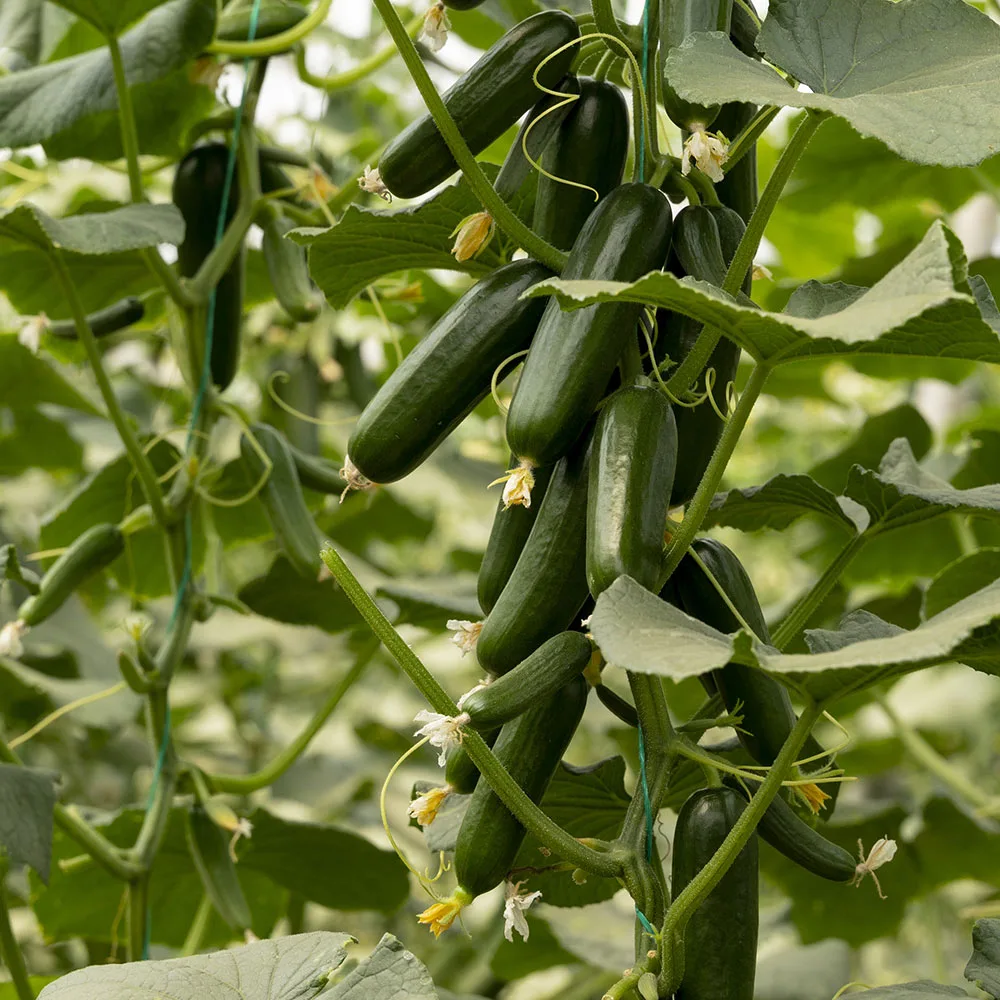
Cucumbers
Cucumbers benefit greatly from vertical growth, which helps keep the fruit clean and reduces the risk of ground rot. An obelisk provides the perfect structure for cucumbers to climb, allowing them to grow in a controlled and organized manner. This setup also makes it easier to spot and harvest ripe cucumbers.
- Best Varieties: Look for climbing varieties like ‘Marketmore’ or ‘Boston Pickling.’
- Maintenance Tip: Regularly tie the cucumber vines to the obelisk as they grow to ensure they follow the structure and don’t sprawl on the ground.
Available via Suttons.co.uk
Evergreens and Vines:

Ivy
For year-round greenery, ivy is an excellent choice for an obelisk. Ivy climbs quickly and can cover an obelisk with dense foliage, adding visual interest even in the off-season. Ivy is particularly useful in formal gardens, where its uniform growth can contribute to a structured, elegant appearance.
- Varieties: English Ivy (Hedera helix) is a popular choice for its vigorous growth and resilience.
- Maintenance Tip: While ivy is low-maintenance, it can become invasive, so regular trimming is necessary to keep it in check and prevent it from overtaking other plants.
Available via Suttons.co.uk

Honeysuckle
Honeysuckle is a fragrant vine that offers both beautiful flowers and a delightful scent, making it an ideal candidate for growing on an obelisk. It’s a great way to add sensory appeal to your garden, attracting pollinators like bees and butterflies.
- Ideal Environment: Honeysuckle thrives in full sun to partial shade and prefers moist, well-drained soil.
- Maintenance Tip: Prune after flowering to maintain its shape and encourage more blooms the following season.
Available via Suttons.co.uk
Best Plants for Garden Obelisks
| Plant Type | Examples | Key Benefits | Special Considerations | SEO Keywords |
| Climbing Flowers | Clematis | Vibrant blooms in various colors, adaptable | Regular pruning needed; requires initial support | Flowering vines, clematis care, vertical gardening |
| Wisteria | Dramatic cascades of flowers, bold focal point | Needs strong support; biannual pruning required | Wisteria pruning, flowering obelisk plants, garden focal points | |
| Edible Plants | Peas and Beans | Easy to grow, improves soil nitrogen, simplifies harvesting | Anchor obelisk securely; heavy when full of pods | Vertical vegetable gardening, peas and beans support, space optimization |
| Cucumbers | Clean fruit, reduces ground rot, easier harvesting | Regular tying required to guide growth | Cucumber trellis, vertical growth, vegetable support | |
| Evergreens & Vines | Ivy | Year-round greenery, fast-growing | Can become invasive; regular trimming needed | Evergreen obelisk, ivy maintenance, garden structure |
| Honeysuckle | Fragrant flowers, attracts pollinators | Prune after flowering for shape maintenance | Honeysuckle care, fragrant vines, pollinator plants |
Conclusion: Embrace the Transformative Power of Garden Obelisks
Reflecting on Their Versatility
As we’ve explored throughout this article, garden obelisks are far more than just decorative elements; they are versatile structures that can significantly enhance both the functionality and beauty of your garden. From supporting climbing plants to serving as eye-catching focal points, obelisks can be adapted to suit various garden styles, whether you’re cultivating a formal garden with precise symmetry or a charming, whimsical cottage garden.
Practical and Aesthetic Benefits
Obelisks offer practical benefits by maximizing space and improving plant health through vertical gardening. They also provide seasonal versatility, allowing your garden to remain visually appealing all year round. Whether you’re looking to increase your vegetable yield in a compact space or create a stunning display of flowering vines, obelisks are a reliable and elegant solution.
Your Next Steps
Now that you’ve gained insights into how to effectively use garden obelisks, it’s time to put these ideas into practice. Consider the unique needs of your garden and choose an obelisk that complements your space. Whether you’re a seasoned gardener or just starting out, implementing obelisks can elevate your garden’s design and functionality, making it a true reflection of your creativity and care.
Final Thought
Embrace the transformative power of garden obelisks, and watch as your garden flourishes into a space of beauty, productivity, and harmony. As you continue your gardening journey, let these elegant structures guide your plants to new heights, both literally and figuratively.





